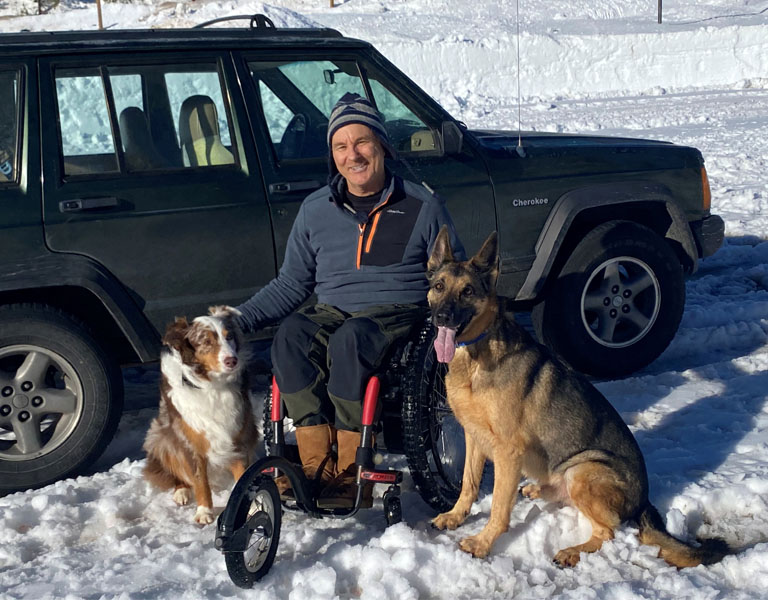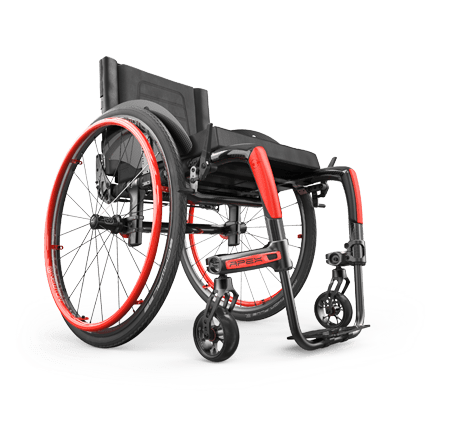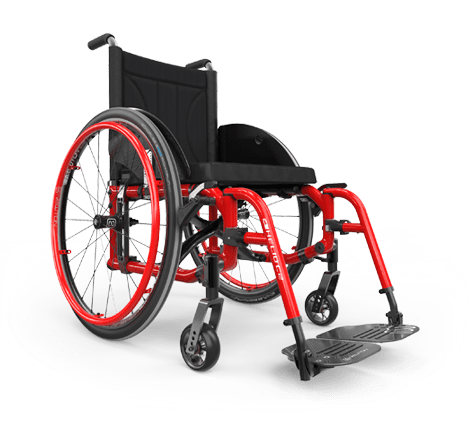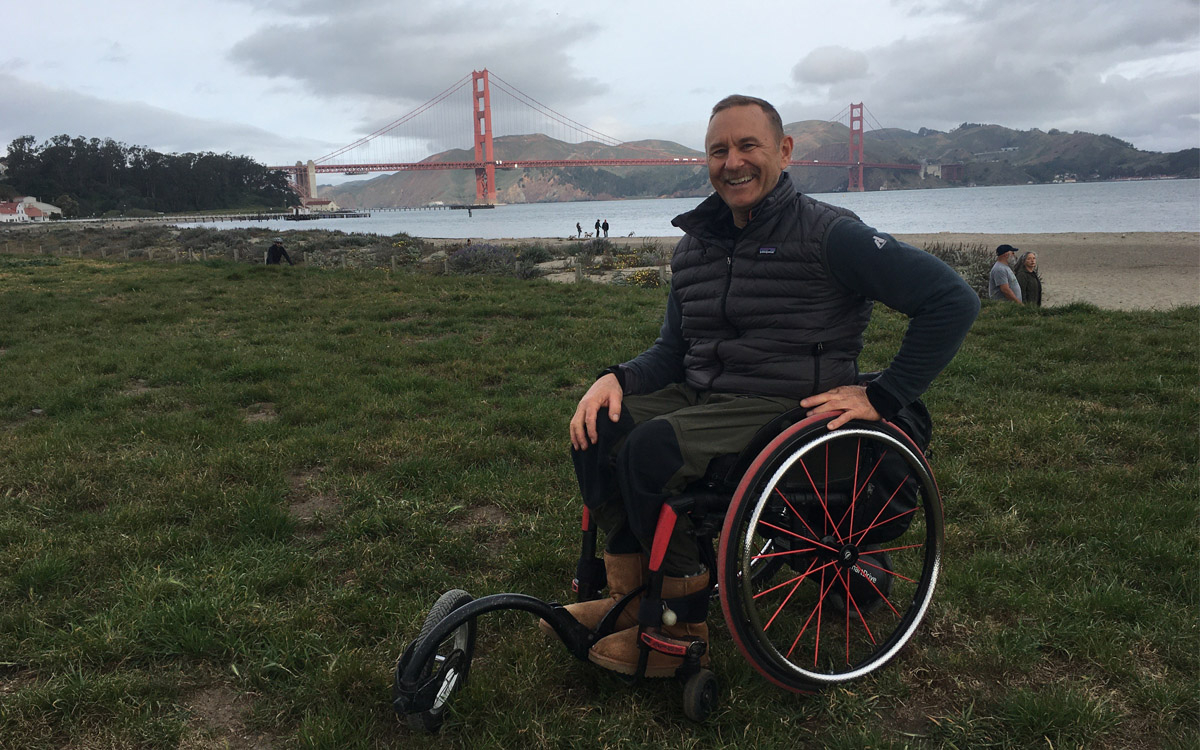(If you haven't, make sure to also read Part I & Part II of "Tips I've Learned in 36 Years as a Wheeler" Series by Bob Vogel).
CASTERS
Like all parts of wheelchair set up, choosing the optimal casters--AKA front wheels--will vary depending on your wheelchair skills, center of gravity setup as well as your environment.
The main choices in casters are diameter, width, and density. Over the years I have used a wide variety, ranging a brief stint with 8” casters--that were great off-road but fluttered like crazy at anything above a walking speed, to 3” roller blade wheels which perform great on smooth surfaces but tend to catch on pavement cracks and/or small stones, in my case resulting the occasional forward tumble.
The diameter of your caster will have an impact on the ease for the end user to pass over obstacles and maintain the propulsion speed. Several friends who live in the mountains and spend lots of time off-road and in the snow, prefer to go with 5” diameter, 1 ½” soft roll casters, the larger size rolls over bigger obstacles and their chair set-ups tend to be less tippy than mine which puts more weight on the front casters.
In my experience, casters that are diameter 6” or larger have a tendency to flutter at higher speeds and I would reserve going to that size unless advised by an ATP or clinician.
The width will decrease rolling resistance; this means that a narrow caster will work good in smooth surfaces, and a wider caster will make it easier for the user to pass over bumpier roads, which makes them more desirable for an outdoor environment.
If you want to learn more about casters, make sure to read the Motion Composites blog: FRONT CASTERS FOR MANUAL WHEELCHAIRS - PRACTICAL GUIDE.
I find the sweet spot in casters for a majority of wheelers, including myself, are 1 ½”-wide, soft roll casters in either 4”, or 5” diameter. These days my wheeling is part urban, and part off-road and using 4” diameter, 1 ½” wide soft roll casters with a composite hub provides a smooth, swift, ride with zero flutter, and as the name suggests, a ‘soft roll’ caster provides a slight amount of give when rolling over a crack or pebble which provides a smoother ride. Caveat, there is generally an upcharge when ordering soft roll caster, however in my experience it is well worth it.

Bob Vogel in his 14'' width APEX C with his dogs Nikko and Killy.
REAR WHEELS
In choosing rear wheels the starting place is rim diameter. The most common sizes for wheelchairs are 24” (540) rims, followed by 25” (559) rims. Although close in size, there slight advantages and disadvantages to each size. A 24” rim provides slightly better torque, meaning it is slightly easier to start movement, and a bit easier to push up hills compared with a 25” rim. On the other hand, a 25” rim has an edge when pushing at a higher speed. Another advantage with a 24” rim is easier to transfer into the car (by being slightly smaller).
I have gone back and forth between 24” and 25” rims and I prefer a 25” rim for the speed advantage. In general, I only see 26” rims used by wheelers that are very tall, or on specialty sports chairs where top speed is an advantage. Also, transferring 26” wheels into the car is a bit tighter.
In my experience, standard spoked wheels are great, however if finances allow, upgrading to a lighter, stronger wheel is worth it. It makes for easier pushing, and lighter wheels pleasantly noticeable when transferring each wheel into and out of the car.
TIRES
A big question on tires is whether to go with pneumatic (air) tires, or solid tires (soft urethane, or a pneumatic with an airless insert). I have used both and in my experience urethane tires ride great, however pneumatic tires are lighter and have an edge in performance, the downside is they can also go flat. However. if you or somebody close to you is comfortable changing tires, it is easy enough to carry a spare tube and tire levers to do a quick fix. However, if this isn’t an option, go with urethane or airless tires.
The next choice is what size (width) and tread pattern. For my daily wheeling, I prefer a 1” high pressure tire with a smooth, running surface (no tread) vs. a tight tread pattern as I find dirt tends to pack into the tread and come loose in my house and/or the back seat of my car. On the other hand, zero tread is worthless in snow, hence I can see the advantage of a 1” treaded high-pressure tire for colder climates.
For me, when it comes pushing off-road, the beach, camping, or in the snow, nothing beats a knobby mountain bike tire that is at least 2.0” wide. My current off-road tires are 2.25” wide. It is also easy to knock snow and/or dirt off the wider-spaced tread of a knobby tire prior to going into the house transferring into the car.
There are several caveats when switching to mountain-bike tires. They are wider and may rub on seat posts--fortunately rear-wheel spacing can be adjusted on all Motion Composites chairs to adapt for this. Also, changing from a 1” tire to a 2.0”-2.5” tire increases the diameter of the wheel, and will raise the back of the chair by about an inch or more. One way around this is to measure the back of your seat upholstery with your everyday tires, then switch to the mountain bike tires and re-adjust (lower) your seat bucket angle to where it was. You will also have to re-adjust your wheel locks for the larger tire. For more on tires, make sure to read this article of New Mobility Magazine.

Bob Vogel in his 14'' width APEX C- In front of the Golden Gate Bridge in San Francisco.
CAMBER
Camber is the side angle of rear wheels. In my early post-injury years, it was fun to run 6-degrees of camber which made the chair look super sporty and made for insanely snappy turns. But the more the camber, the wider the chair and I got tired of such a wide wheelbase preventing me from entering narrower doorways. So, I went the other direction--I switched to 0-degrees of camber giving me a super-narrow 20” width.
Going with 0-degree camber did slow my turning performance, a wheel would slide just a bit when trying to make a quick turn, and my chair was less ‘side-to-side’ stable resulting in the occasional side tumble on steeper off-camber surfaces, something that was no big deal in my younger days. However, a sideways fall, 15-years post injury, resulted in a broken hip. While recovering I increased my camber to 2-degrees--something I now suggest as a ‘rule of thumb’. For me two degrees is perfect--my chair is still quite narrow yet adding 2-degrees provides significantly more side-to-side chair stability and snappy turns. To learn more about camber, make sure to read Motion Composites blog: CAMBER: DEGREES OF PERFORMANCE.









